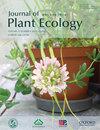Effects of floral traits on geitonogamous selfing rates and reproductive success in a protandrous species
IF 3.9
2区 环境科学与生态学
Q2 ECOLOGY
引用次数: 1
Abstract
Through its role in regulating pollinator behavior, floral display size and nectar gradient within inflorescences may alter the extent of geitonogamy and thus female reproductive success in protandrous species. However, this has seldom been examined. By quantifying selfing rate, seed number and male donor number, we estimated the effects of floral display size, nectar gradient and their interactions on plant reproduction in protandrous Aconitum gymnandrum. At plant level, selfing rate and seed number increased with a larger floral display of both main and lateral inflorescences but reduced with a declining nectar gradient. The effects of floral display of the main inflorescence on selfing rate and seed number were altered by the nectar gradient and floral display of lateral inflorescences as shown by their interactions. Larger floral display of the main inflorescence reduced male donor diversity. At flower level, the selfing rate and the seed number varied among flower positions, in which bottom flowers had lower selfing rate and higher seed number than top flowers. The effects of floral traits on geitonogamous selfing rate and seed number were inconsistent among flower positions. Although low cost of geitonogamous selfing for reproduction was tested by hand-pollination, the selfing rate was negatively correlated with seed number and male donor number in open-pollinated population. Our results suggest the potential role of trade-off between geitonogamy cost and reproductive benefit on evolution of floral traits. The variation of selfing rate and reproductive success among flowers may alter the trade-off and thus complicate evolution of traits.花的性状对一个雄性前体种的无性繁殖率和繁殖成功率的影响
通过其在调节传粉昆虫行为中的作用,花序内的花朵展示大小和花蜜梯度可能会改变给力交配的程度,从而改变雄性物种的雌性繁殖成功率。然而,这一点很少得到研究。通过量化自花率、种子数量和雄性供体数量,我们估计了花的展示大小、花蜜梯度及其相互作用对裸子乌头植物繁殖的影响。在植物水平上,自交率和种子数量随着主花序和侧花序的花展增加而增加,但随着花蜜梯度的下降而减少。主花序的花显示对自交率和种子数量的影响受到侧花序的花蜜梯度和花显示的影响,如它们的相互作用所示。主花序较大的花展减少了雄性供体的多样性。在花水平上,不同花位的自交率和种子数不同,其中底部花的自交率较顶部花低,种子数较高。花位性状对自交结实率和种子数的影响不一致。尽管人工授粉测试了自交繁殖的低成本,但在开放授粉群体中,自交率与种子数量和雄性供体数量呈负相关。我们的研究结果表明,世代交配成本和繁殖效益之间的权衡对花性状进化的潜在作用。花间自交率和繁殖成功率的变化可能会改变这种权衡,从而使性状的进化复杂化。
本文章由计算机程序翻译,如有差异,请以英文原文为准。
求助全文
约1分钟内获得全文
求助全文
来源期刊

Journal of Plant Ecology
生物-植物科学
CiteScore
4.60
自引率
18.50%
发文量
134
审稿时长
3 months
期刊介绍:
Journal of Plant Ecology (JPE) serves as an important medium for ecologists to present research findings and discuss challenging issues in the broad field of plants and their interactions with biotic and abiotic environment. The JPE will cover all aspects of plant ecology, including plant ecophysiology, population ecology, community ecology, ecosystem ecology and landscape ecology as well as conservation ecology, evolutionary ecology, and theoretical ecology.
 求助内容:
求助内容: 应助结果提醒方式:
应助结果提醒方式:


